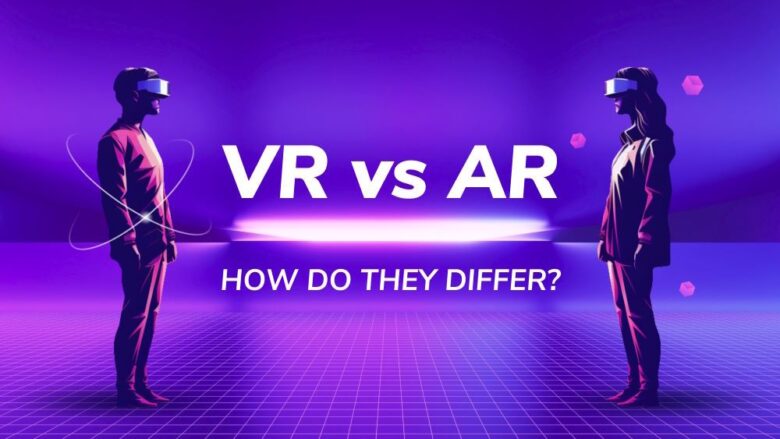The metaverse is an ever-expanding digital world where people can interact with each other and explore virtual environments. VR and AR are important metaverse technologies. Both affect the experience of digital space in different ways. They may look the same, but they offer different user experiences and technological options. Understanding the differences between VR and AR is crucial to understanding the metaverse and its future.
The True Meaning of Virtual Reality:
VR creates a truly immersive digital environment. People immerse themselves in the simulation when using VR glasses. This environment can be a game, a virtual office, or a social space that appears real or magical. The user’s perspective is closed off from the physical world, and their senses are focused on the digital world. Sensors allow users to explore and interact with avatars and objects in this artificial world.
How Augmented Reality Works Differently:
AR does things differently. AR adds digital elements to the physical environment. Smartphones, tablets, and AR glasses send digital images, information, and animations to users as they view their surroundings. Popular apps show how furniture looks in a living room and bring animated creatures to life, like Pokémon GO. Unlike VR, AR can enhance the environment.
VR vs. AR Experiences Compared:
VR gives people the feeling of entering another world. Wearing the headset and holding the controllers makes you feel like you’re in the game. VR is perfect for immersive experiences like virtual concerts, training simulations, and fully interactive games. AR adds layers to the real world while maintaining connectivity. You can navigate your home or business while receiving digital information, such as navigation instructions or real-time instructions for equipment repairs. AR is more suited for mobile or practical purposes.
Hardware Requirements and Accessibility:
VR hardware tends to be more specialized. For a full VR experience, you need a good headset, motion sensors, and occasionally a powerful computer or game console. These are expensive and require a safe circulation space. AR, on the other hand, is more accessible. Most smartphones and tablets support AR apps, and AR glasses are getting better and cheaper. For everyday use, most people will have no problem using AR.
Metaverse Use Cases:
VR and AR play different roles in the metaverse, but both are important. VR is suitable for social activities in virtual worlds, immersive games, and digital training simulations. Users can enter a new space and interact with others in the same virtual world. AR makes the metaverse more integrated with everyday life. It can generate digital minutes of real meetings, let people virtually try on clothes in a store, or help complete collaborative tasks without leaving the environment.
Business and Education in VR/AR:
VR enables remote teams to meet virtually, share briefings, and collaborate in person in a virtual workplace. The immersive nature of VR is beneficial for medical, aerospace, and engineering training. AR adds guidance or real-world data to real-world tasks. VR allows students to take virtual field trips or reenact historical events, while AR can make textbooks on phones and tablets interactive.
Interpersonal Relationships and Socialization:
The metaverse relies on social connection, and VR and AR offer alternative ways to connect. VR allows people to share virtual spaces, interact with avatars, and feel like they’re in the same place even when they’re thousands of miles apart. Such experiences can encourage a sense of community and inclusion. AR allows people to interact with digital elements of real life. Friends can play a multiplayer AR game in the park, or colleagues can share an AR screen during a meeting. Each technology connects people in different ways.
Gaming and Entertainment Opportunities:
VR and AR are changing the way people play games and consume entertainment media. VR immerses players in the game world. This makes VR attractive for action, adventure, and exploration games. AR enhances gaming by bringing it into the user’s environment. It combines the real world with digital games, creating new challenges and excitement. In live events, AR is used to project digital effects onto a real stage or location.
Impact on E-Commerce and Retail:
VR and AR are also changing retail. With VR, companies can create virtual stores where customers can view, try on, and buy products without leaving their homes. Customers can use AR to view real-life images of clothing, furniture, and cosmetics before making a purchase. Virtual experiences and real-world applications increase customer satisfaction and reduce returns. Companies that use these technologies can gain an edge in the metaverse market.
Why the Difference Between VR and AR Matters:
Understanding VR and AR can help people and businesses use them more intelligently. They can use both approaches or choose one over the other, depending on their goals. VR is ideal for immersive experiences that require focus and presence. AR combines digital content with real life, enabling practical applications and everyday engagement. Deploying the right technology requires an understanding of its capabilities.
The Future of VR/AR in the Metaverse:
The distinction between VR and AR may become more hazy as technology progresses. Mixed reality (MR) combines both, offering an adaptive experience that alternates between full immersion and real-world interaction. In the future, electronic devices may support both VR and AR, allowing users to switch modes based on different tasks. Advances in 5G, wearable technology, and software will drive this transformation. Users and investors can prepare for the future of mixed reality by understanding these differences.
Conclusion:
VR and AR are powerful technologies that are shaping the metaverse on multiple levels. While VR immerses you in a digital world, AR adds digital elements to reality. Each method has its pros and cons and specific applications. As the metaverse grows, users, developers, businesses, and educators need to understand the differences between VR and AR. These technologies work together to create a more vibrant virtual ecosystem. To succeed in the ever-changing digital landscape, you need the right tools for the right experience.
FAQs:
1. How do you think AR is different from VR?
AR integrates digital elements into the real world, while VR replaces the real world with a completely digital world.
2. Can AR and VR be combined?
Researchers are currently developing a technology known as mixed reality (MR), which combines virtual and real situations.
3. Which is more cost-effective for beginners, AR or VR?
VR requires specific headsets and technology, but AR is generally easier to use because it works on most smartphones and tablets.
4. VR or AR: Which is better for gaming?
Both offer a unique gaming experience. While AR adds a digital element to real-world actions, VR is best suited for realistic, three-dimensional worlds.
5. Why is it important to understand how VR and AR change in the metaverse?
Understanding these differences can help users and businesses choose the technology that best suits their goals, whether it’s real-world engagement or deep immersion.




